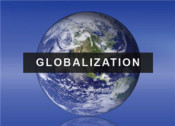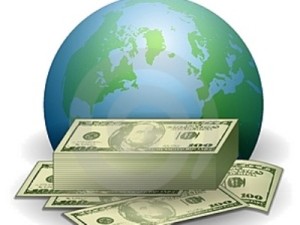
Global Economics in History
Globalization encompasses the changes regarding international trade and economy; falling trade barriers, unrestricted capital flows fueled by technological innovation, and a new mobile global work force would all combine. The global economy transforms by online financial markets, transnational mergers and currency speculation that dwarfs trade in goods and services. It is crucial that countries guarantee they are fostering a culture that encourages alertness, responsiveness, flexibility, and speeding up the cycle time of processes and decisions. For in order to reap the benefits of globalization, countries must make the necessary investments in education, health, and social safety nets. Technology spurs expansion, which is seen in such results as access to the internet, innovative information flow, knowledge of cultures, and new markets. The “New Rules of the Game” segment of Commanding Heights focuses on the interrelationship of trade policy, international capital flows and exchange rates; also, their subsequent influence in the spread of globalization in the 1990s, the Mexican Debt Crisis, and the Asian Economic Crisis.
NAFTA is an international organization acronym for the North American Free Trade Agreement. The belief of the organization is that open markets create wealth, bind nations together, and help construct a more prosperous and more secure world. The initial concept created a whirlwind of controversy in the white house and came to be the first great debate of the globalization era. When put to a vote, it passed by Republican vote alone; they were behind the concept and President Clinton one hundred percent; Democrats were at sixty percent against the plan. Immediately after NAFTA became law, thousands of foreign companies built factories in Northern Mexico, exporting goods to the American market just a few miles away. The cost/benefit ration of the new law was dependent on the country and varied along a wide spectrum. The United States saw a slight increase in exports, 90-160,000 additional jobs, but lost 140,000 textile jobs to Mexico. Canada saw a loss of 50,000 jobs; the country imports heavily from the United States and unfortunately, they also witnessed their currency being devalued. Mexico gained 600,000 new textile jobs, offset by other losses, and saw an increase in imports from the United States. Other countries that suffered mainly saw the unrest among the organized labor unions. The other countries that won the beneficial ticket observed increased satisfaction among consumers and multinational corporations. Washington’s free-trade agenda passed seamlessly from the Clinton to the Bush administration. NAFTA contributed to the strength of the United States’ economy because of a substantial increase in exports and in turn, more exports helped in the fight to reduce inflation.
Technology spurs expansion and in the expansion of global financial markets, along with the introduction of the internet, innovative information flow, and a newfound knowledge of cultures and new markets, pension funds became the powerhouses of the global economy because they had the money. With the mentality that everything is global and interconnected, the end of the cold war observed many nations opening their markets to foreign investment for the first time. Online financial markets, transactional mergers, and currency speculation that dwarfs trade in goods and services transformed the global economy. The arrival of a global marketplace sparked intense competition and perpetual burdens on costs. In order to reap the benefits of globalization, countries would need to make the necessary adjustments in education, health, and social safety nets. As investment flowed around the world, the Clinton administration expanded the trade agenda it adopted with NAFTA. The United States encouraged developing nations to continue opening their economies to the global market. Many of the developing countries had been colonies of the west and saw the quick-moving flows of capital as a threat. The complexity of global markets creates possibility for unforeseen disasters, increases the risk of “external shocks”, and the interconnectedness of a global economy translated to the possibility of problems originating and spreading across the system. During the 1990s, the number of countries that adopted free market economies was inconceivable; it was being called “the triumph of capitalism. The general movement away from traditional state control of the commanding heights marched on, allowing more and more control to be handed over to the realm of the market. Thus commenced the primary, truly global, economy that was integrated and interconnected; work and production were networked around the world and the accompanying knowledge of commerce, etc. had taken digital electronic form. The transition away from central control has had its pros and cons; productivity levels increased substantially and wealth had begun an upward slope; the voyage however was dismal at best and societally wrenching for peoples of several nations. Technology has fundamentally altered the manner in which economies conduct themselves in order to integrate and interrelate.
The Mexico Debt Crisis can best be described as an epic meltdown. The day NAFTA went into effect, Zapatista rebels launched an uprising in southern Mexico resulting in the assassination of the leading presidential candidate. Increased concern with stability, foreign investment fled the scene hastily. The global economy was about to face a new standard of crisis. After considerable deliberation, it became apparent that without a substantial commitment from the United States, Mexico would go into default on all of its debt, be forced to impose comprehensive exchange controls, and quite frankly shut down its economy. Against the majority counsel, President Clinton chose to see the big picture. He learned that the effect a failure of these proportions in Mexico would undoubtedly impact the United States economy negatively. Choosing to bail Mexico out of it’s dire economic situation would help the American economy more than it would injure it. Although an exceedingly controversial resolution, American taxpayers after all was said and done profited by $500 million.
By early 1997, Southeast Asia’s rapid economic boom was beginning to overheat. During the 1990s, Thailand had opened up its capital markets. For the first time, local businesses could borrow money from foreign banks that offered lower interest rates. In only four short years, Thai businesses had exceeded over $200 billion in loans. American and European governments however were encouraging the inflow of capital. Asia experienced an enormous influx of capital, institutional weakness, underdeveloped markets, inadequate securities laws, and “pegging” as monetary policy. Thailand’s central Bank had kept its currency artificially high. Concern began to rise and the International Monetary Fund began to fear a fall in Thailand’s economy. The baht, Thailand’s currency, was pegged to the dollar but with the weakening economy, there was a sense of this not lasting. In July of 1997, Thai government had no choice but to devalue currency signifying the disastrous creation of the Asian financial crisis. Cost of living began to rise; costs in general began to rise for necessities such as water, electricity, and even soap; however, salaries were stagnating. The Thai economy was in dire straits and experiencing a virtual free fall that essentially led to an attempted rescue loan from the IMF. The unfortunate persistence of their economic crash progressed to an additional request of monetary aid from the United States. The notion of an economy as miniscule as Thailand’s containing the capacity to cause a global crisis was, until that moment in history, unfounded and ridiculous. Increased global concern led to the immediate analysis of possible repercussions deliberating the probability of other countries having comparable secret failings. The onset of the “Contagion” was initiated and like a disease, it spread with the fastidiousness of an elaborate scheme, infecting strategic locations within the economic globe. As it spread to Thailand’s neighbors, Malaysia had seemed healthy until infection ensued, resulting in economic failure. Following closely was Indonesia, the most populous of the region, suddenly infested triggering a collapse in government and chaotic reactions. The IMF was astonished; this was an unprecedented encounter prompting innovative action. Substantial loans were immediately organized for Indonesia and other Asian nations under the strict conditions to cut government spending, raise interest rates, and eliminate corruption. “Contagion” was disparagingly ambitious and thwarted all efforts at containment, seizing Korea’s extremely successful economy as the subsequent victim. Discovering Korea’s misdirection as a result of the cataclysmic attack commanded a further understanding. The country had been misleading the world, claiming it possessed adequate capital to resist the impending disaster when in reality, it was on the brink of defaulting on all Japanese and Western loans. Korea received the most prevalent bailout in history, resulting in the contagion moving to Russia. The economic plague appeared to have mutated into an intelligent thing, capable of making choices that ultimately resulted in tragedy and America was next on the chopping block. This thing, a phenomenon of globalization, had its sights set on Wall Street; failure on Wall Street threatened the entire global economy; correspondingly, the fate of the global economy rested in the hands of private bankers. Wall Street had encouragingly deflected the plague but Contagion wasn’t done yet. Brazil seemed to be the final destination, the world’s eighth largest economy. A loan package was proactively put into effect early and Brazil’s government immediately cut spending and enacted reforms. SUCCESS!! Brazil’s distresses were contained and thankfully the Contagion had fizzled out. Global financial markets gradually returned to normal.
The world economy had survived the first crisis of the globalization era, but millions of ordinary people had paid the price. Afterthought allowed theorists to determine that the Asian Crisis was not the seizure of a normal business cycle but the consequence of an external shock—the excessive influx of foreign capital pursuing higher yields in emerging markets. The bailout in Mexico was successful and Mexico paid back the loan early. The intervention concerned minds as it set a dangerous precedent: protecting big investors from risks they had willingly taken. The rapid pace of globalization in all dimensions requires new rules. Existing systems must function in harmony with the marketplace. Globalization challenges governments to cooperate with one another in order to develop the new rules of the game, specifically the requirements for a manageable and successful global marketplace.
